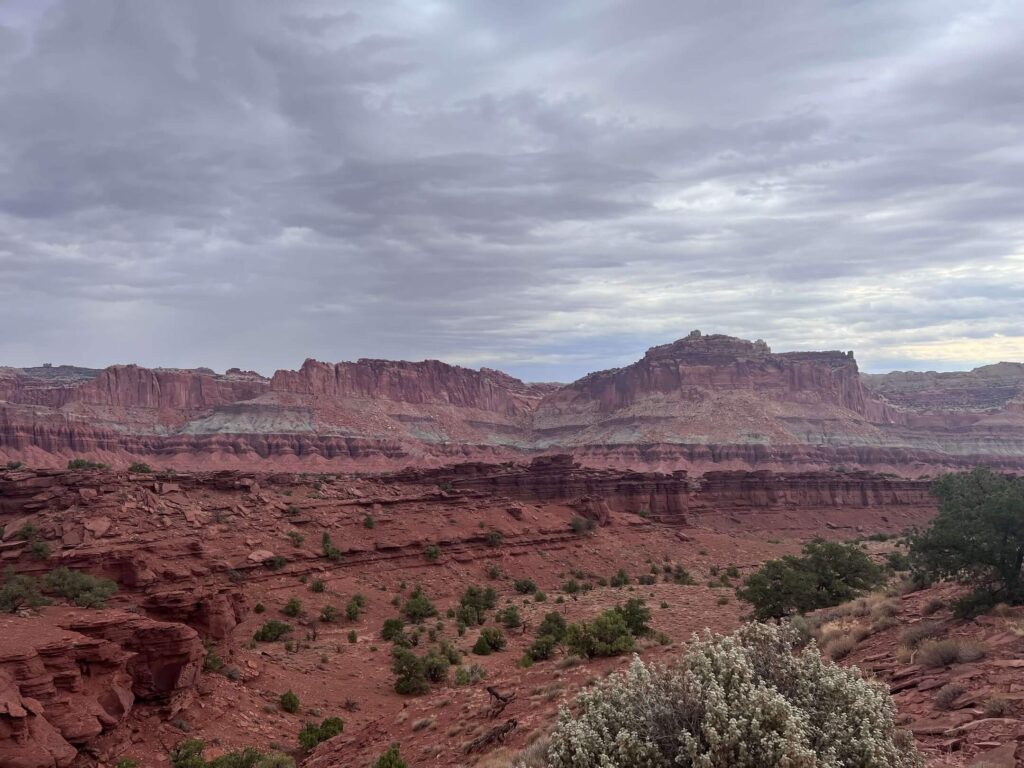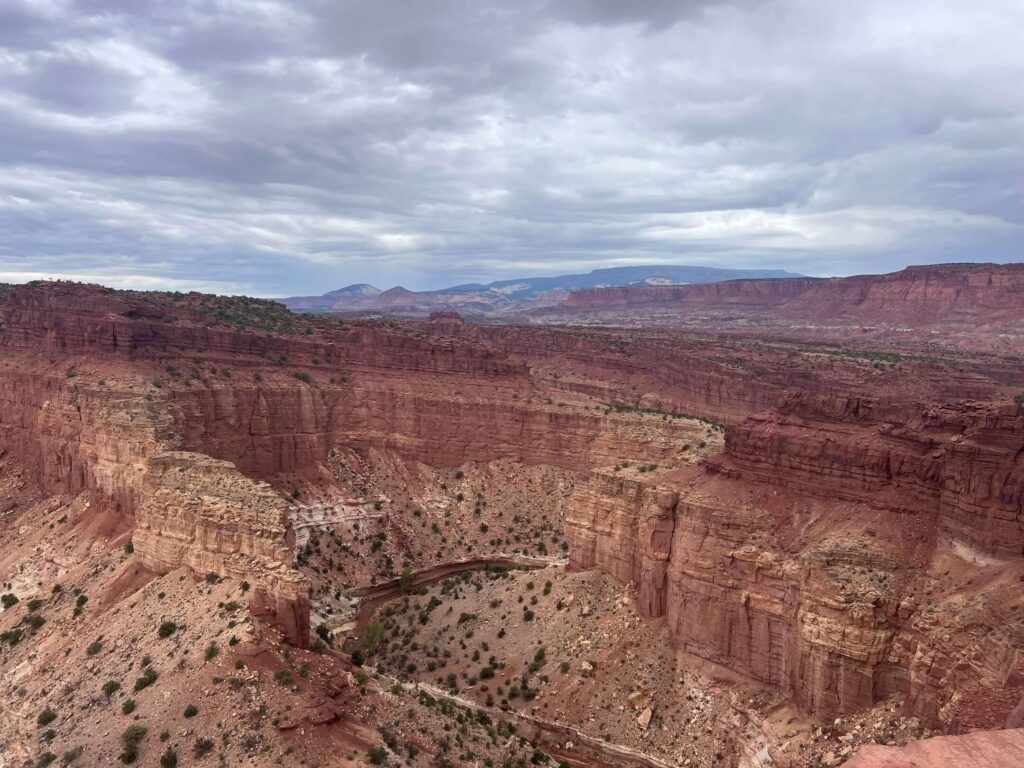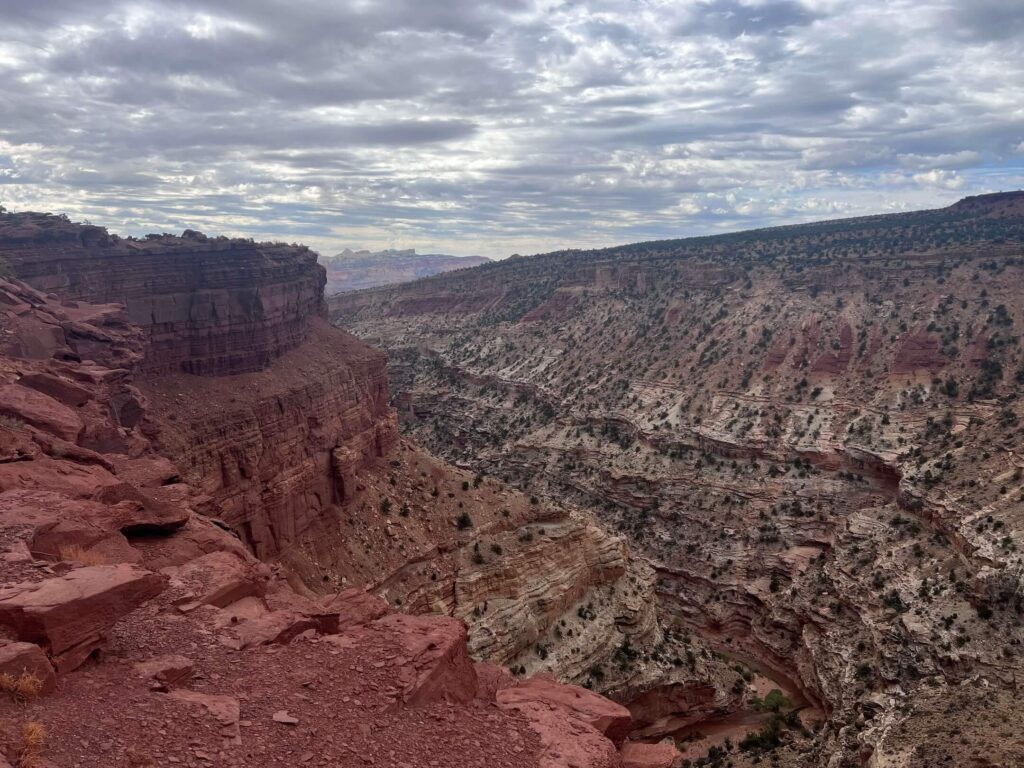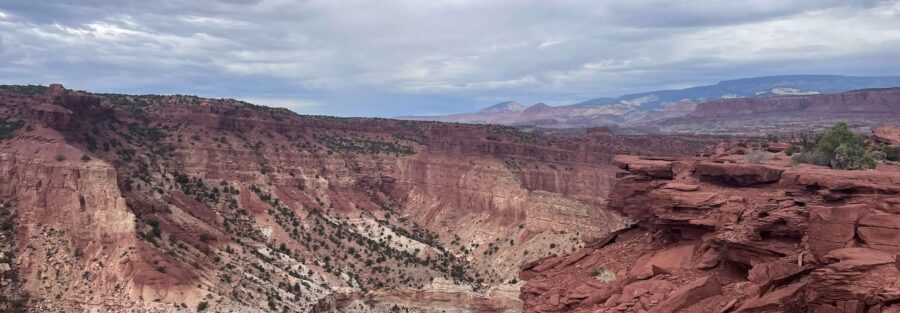Quick Facts:
Location: Capitol Reef National Park
Coordinates: 38.29903617730197, -111.29771191469204
Length: 2.5 Miles
Difficulty: Easy
Elevation Gain: 300 Feet
Dog Friendly: No
Introduction:
Capitol Reef National Park, located near the quaint town of Torrey, Utah, is a paradise for those who love breathtaking views and serene landscapes. Among the park’s many attractions, Goosenecks and Sunset Point stand out as two of the most accessible and awe inspiring overlooks. These short trails offer stunning panoramic views of the park’s rugged terrain, making them perfect for visitors looking to experience the beauty of Capitol Reef without a strenuous hike. Whether you’re starting your day with a sunrise at Sunset Point or ending it with the dramatic vistas of Goosenecks, these trails promise an unforgettable experience.
How to Get There:
Capitol Reef National Park is easily accessible via Utah State Route 24, about 11 miles east of Torrey. If you’re driving from Salt Lake City, expect a scenic 3.5 hour journey, while those traveling from Moab can reach the park in just under 2.5 hours. There is a $20/Vehicle to enter Capitol Reef, however the American the Beautiful pass gets you in for free. The trailheads for Goosenecks and Sunset Point are located near each other, just off Route 24. To get there, drive along the main park road until you see signs directing you to the Goosenecks and Sunset Point parking area. The road is well marked and easy to follow.

Parking Information:
Parking for Goosenecks and Sunset Point is available in a shared lot near the trailheads. The lot is spacious and typically has plenty of room, even during peak seasons. Since these are popular spots, especially around sunrise and sunset, it’s still a good idea to arrive early to secure your parking space. The trails are just a short walk from the parking area, making these overlooks highly accessible for visitors of all ages and abilities.
Description of the Landscape:
The landscapes surrounding Goosenecks and Sunset Point are nothing short of spectacular. The Goosenecks overlook provides a bird’s eye view of the Sulphur Creek as it meanders through the steep, narrow canyons, creating a series of sharp, winding turns reminiscent of a gooseneck. The sight of the creek carving through the deep red rock is both humbling and awe inspiring, showcasing the incredible power of nature.
Sunset Point, just a short distance away, offers sweeping views of the Waterpocket Fold, a nearly 100 mile long wrinkle in the Earth’s crust that defines the park’s unique geology. As the sun sets, the rock formations come alive with color, shifting from warm oranges and reds to deep purples and blues. It’s a peaceful spot to reflect on the day’s adventures and soak in the natural beauty of Capitol Reef.

Trail Difficulty and Length:
The trails to both Goosenecks and Sunset Point are short and easy, making them accessible to nearly everyone. The Goosenecks Trail is approximately 2.5 miles, with minimal elevation gain, making it a quick walk from the parking area to the overlook. Both trails are suitable for families with young children, elderly visitors, and those looking for a relaxing, scenic walk rather than a challenging hike.
Dog-Friendly Information:
Pets are not allowed on the Goosenecks or Sunset Point trails. Capitol Reef National Park has restrictions on pets to protect the fragile environment and ensure the safety of wildlife and visitors. If you’re traveling with a dog, you’ll need to explore other pet-friendly areas outside the park, as most trails within the park have similar restrictions.
Local Regulations:
When visiting Capitol Reef, it’s important to follow all park regulations to help preserve its natural beauty. Visitors should stay on designated trails to prevent damage to the delicate desert ecosystem. The park also follows Leave No Trace principles, which means packing out all trash, avoiding picking plants or disturbing wildlife, and respecting other visitors. Additionally, as a designated dark sky park, Capitol Reef encourages minimizing light pollution, so consider turning off or dimming lights at night to preserve the incredible starry skies the park is known for.

Other Trails Nearby:
Capitol Reef National Park offers a variety of other trails that are worth exploring. If you’re looking for a more challenging hike, the Hickman Bridge Trail offers a moderate trek to a stunning natural bridge, while the Cassidy Arch Trail provides dramatic views and the chance to stand atop an impressive arch. For a less strenuous walk, the Grand Wash Trail takes you through a narrow canyon with towering walls, a perfect complement to your visit to Goosenecks and Sunset Point.
Non-Hiking Attractions Nearby:
Beyond hiking, Capitol Reef is rich in cultural and historical attractions. The Fruita Historic District is a must-visit area within the park, where you can explore a 19th-century Mormon settlement. Here, visitors can pick fresh fruit from the orchards (in season), visit the Gifford Homestead for homemade pies, and learn about the area’s history. The park’s Scenic Drive offers a leisurely way to take in the stunning rock formations and geological features from the comfort of your car, with several informative pullouts along the way.
Accommodations: Where To Set Up Basecamp
For sweeping views of Capitol Reef and a boutique feel, The Skyview Hotel is a standout. With stylish rooms and an unbeatable location, it’s the perfect mix of comfort and scenery. Guests love the peaceful vibe and the chance to unwind while surrounded by Utah’s red rock beauty.
👉Book your stay at The Skyview Hotel Torrey today and enjoy the view.
Red Sands Hotel & Spa brings modern comfort to Torrey with cozy rooms, an outdoor pool, and a relaxing spa. It’s an ideal spot if you want to pair outdoor adventure with a little pampering. The location makes it easy to explore while still enjoying resort-style amenities.
👉Reserve your room at Red Sands Hotel & Spa now and treat yourself.
Capitol Reef Resort is the ultimate basecamp for exploring Capitol Reef National Park. With a mix of lodge rooms, cabins, and even glamping options, it offers something for every traveler. Guests love the views, friendly staff, and easy access to the park.
👉Click here to book your stay at Capitol Reef Resort and start your adventure.
Best Time to Visit Goosenecks & Sunset Point
The best times to visit Goosenecks and Sunset Point are during the early morning or late afternoon. Sunrise and sunset offer the most dramatic lighting, highlighting the vivid colors of the rock formations and providing the perfect backdrop for photography. The trails are open year-round, but the spring (April to June) and fall (September to October) offer the most comfortable temperatures for hiking. Summer can be hot, with temperatures often exceeding 90°F, so early morning visits are recommended. Winter offers a quieter experience, with the possibility of seeing the park’s landscapes dusted with snow, but be prepared for colder conditions.
Support the Adventure
To make your walls less boring, check out my photography portfolio and bring a piece of the wild and my story into your home.
If you’d like to fuel future adventures, you can donate a coffee on Ko-Fi. Every cup keeps me chasing sunrises and stories.
When you shop using my affiliate links, every click helps support this blog at no extra cost to you. It’s a small way to keep Unicorn Adventure alive and kicking while I keep exploring.
Subscribe to my mailing list for future updates, new stories, and behind-the-scenes adventures.
Stay connected with me on Instagram and Facebook for more photos and daily inspiration.
Thanks for being part of the journey, Unicorn Squadron!


